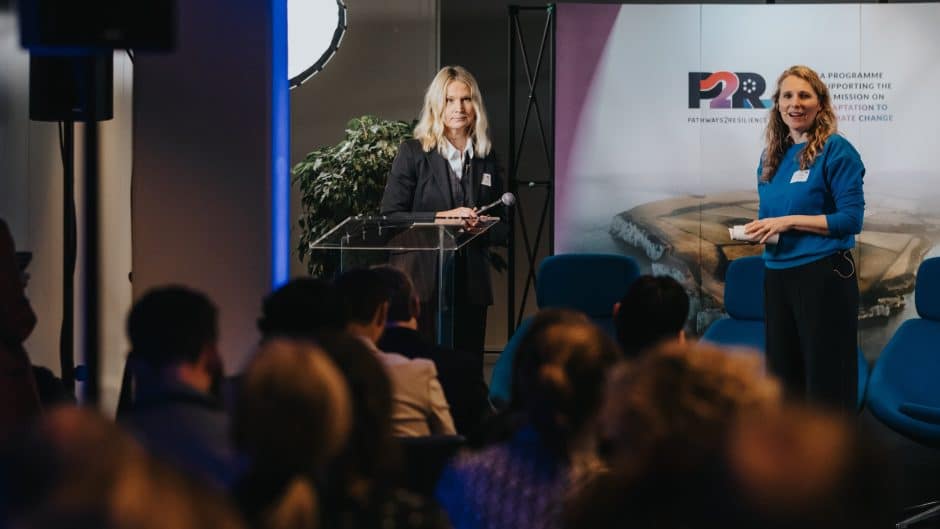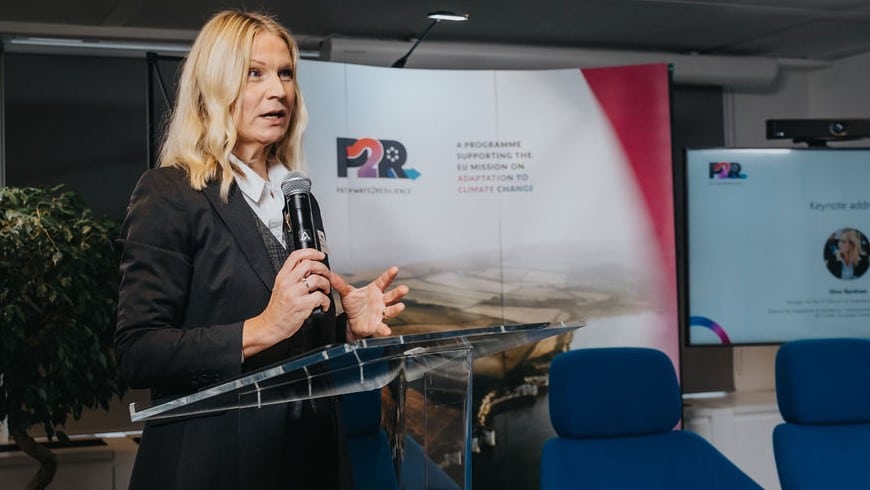Call open for 100 European regions to step up transformative climate adaptation

Pathways2Resilience, the flagship project under the EU Mission for Adaptation to Climate Change led by Climate KIC, has just launched a call for applications to select the first cohort of regions to receive €21 million in direct funding to develop transformative climate adaptation plans. The call was unveiled at a launch event where representatives from the EU Mission and regional authorities explored how this could be a starting point for innovative and radical ways of cross-border collaboration and knowledge exchange.
The urgency of stepping up local adaptation solutions has never been more pressing: 2023 is set to be the hottest year on record, and as Europe warms up twice as fast as other continents, climate disasters such as floods, heatwaves, wildfires, and droughts are becoming more intense, longer and more frequent. However, with the added complications of external crises like pandemics, war, and energy insecurity, the threat is that effective climate action might fall further down the EU bloc’s agenda.
Yet this is far from the case, assures Elina Bardram, Manager for the EU Mission Adaptation at the European Commission. Opening the Pathways2Resilience launch event, she said: “Despite sceptics thinking that climate action and ambition would take a backseat in the face of this turmoil, they have actually become very much the centre of our recovery and also of our energy independence.”
Institutions must step up to the challenge and meet their climate obligations
Throughout her speech, Bardram underscored collaboration as a driving force for effective climate action, emphasising how the EU adaptation strategy aims to promote a more systemic and transformative approach, which departs from business as usual. This includes a greater role for local action, with the goal of encouraging bottom-up solutions that can be replicated and scaled up across regions. “Local people, regional actors who see the impacts of climate change most directly – they also have the best ideas of needs, solutions, the contextualised way of moving forward,” she said.
This, however, needs to be complemented by institutional actions matching the ambition. “The EU Climate Law puts in an obligation for Member States to report on the progress made on adaptation,” Bardram said – noting that the Commission’s first assessment of national climate activities falls short of expectations. One of the findings is the disconnect in, or even absence of, clear governance mechanisms for issues such as finance and risk assessment.
“In December, we will be publishing Member State-specific recommendations, and that’s a very important trigger for what we hope to be a much more intensified activity at the national level. Our citizens, our constituencies, they deserve to know that the institutions are capable of stepping up to the challenge,” she concluded.
Cross-border collaboration to accelerate adaptation maturity
How will the sub-grants and services offered by Pathways2Resilience help regions in meeting their climate adaptation goals? By involving 150 regions during its five-year duration, the project will create a wide network of local communities (representing a significant portion of the European population) at different levels of adaptation maturity. Through workshops, seminars, and a peer mentoring programme, Pathways2Resilience will facilitate collaboration and knowledge exchange between regions on key issues such as access to finance, multi-level governance, and citizen engagement.
Some examples already exist at the national level. Finland has recently established a collaborative network involving six out of 18 regions to foster information and research on adaptation practices. This bottom-up approach closely aligns with both the EU Mission and the Finnish national climate plan, as highlighted by Maaria Parry, Chief Specialist at the Centre for Economic Development, Transport and the Environment of North Ostrobothnia.
It also has the merit of creating a common knowledge hub for regions to learn from each other: “In some of them, adaptation has already been acknowledged with strategies that the regions have to write every four years; in others, they are still gaining an understanding of the impacts of climate change and where to start with planning,” Parry explains.
The importance of innovative approaches in climate adaptation planning
The new methodology for climate adaptation planning offered by Pathways2Resilience was developed by Climate KIC and ICLEI. At its core is concrete guidance on how to develop transformative innovation agendas. This will be done together with the selected regions through Innovation Practice Groups, exploring key steps such as understanding risks, identifying adaptive options, and formulating flexible strategies.
One such innovative approach shifting from traditional reaction to proactive prevention is being explored in Spain’s Extremadura region, in response to its catastrophic wildfires. Fernando Pulido, university professor and coordinator of the MOSAICO project, explains that the low population density (below 10 inhabitants per square kilometre) results in land abandonment and forest encroachment, which increases fire risk. By working with over 300 local initiatives, the MOSAICO project has piloted a participatory fire prevention strategy that successfully reduced fire risk and average fire size, while also allowing to recover 20,000 hectares of previously neglected area through 147 new forestry, agricultural and livestock initiatives.
“But we also need changes and innovation in governance and policies,” adds Pulido. “For example, to improve the payment for ecosystem or prevention services that farmers are performing in these landscapes. Through the engagement of many, many stakeholders at the local level, we are pushing the regional and even national agencies to change these policies. This pressure comes from the experience of the local people in the real world.”
Beyond direct funding: increasing resilience through financial literacy and public engagement
Once the innovation actions have been identified, how can regions find the resources to finance them? While direct funding from Pathways2Resilience is limited to cover this initial strategy development phase, the programme is committed to help regions formulate a robust investment plan to carry out their adaptation strategy on their own. A finance innovation lab will help the selected regions better navigate available public funding and learn how to leverage this money strategically, in a way that can also unlock greater private investment.
Access to finance can be a make-or-break issue for local agencies, often under-resourced and under-staffed, as well as local initiatives and small companies looking to develop grassroot adaptation projects, explains Tereza Fleková, who administers a subsidy programme at the South Moravian Regional Development Department in Czech Republic. So far, her programme has supported over 630 projects with 60 million Czech crowns (around 2.5 million euros) in funding. The total value of these projects, however, has exceeded 400 million Czech crowns (approximately 16 million euros).
Besides the economic potential of sub-grants, the experience has taught Fleková that these processes are crucial in bringing a wide range of experts together, as is often the case for nature-based solutions in adaptation projects: “There have to be adaptation experts to predict what’s going to happen in the future, as well as engineers to figure out what kind of solutions we need. We also need ecologists, landscape architects, urban planners, community facilitators […] This ideally enhances resilience at the local level.”
While planning falls under the remit of regional authorities, officials must not forget that widespread awareness and public engagement are key aspects. South Moravia, for example, holds an annual competition, called ‘Prize for Landscape’, for projects that have a positive impact on adaptation and water retention. “It’s also a way to show appreciation to everyone who takes care of our landscape, and to inspire municipalities, companies and individuals,” adds Fleková.
The Pathways2Resilience call for applications will select 40 sub-grantees, each with a budget of up to €210,000, for an 18-month support period between July 2024 and December 2025. Interested regional authorities can apply before 22 February 2024, and dedicated information sessions will take place in January.
About Pathways2ResilienceRewatch the launch event
Climate KIC is at COP28 in Dubai, UAE, from 30 November to 6 December, to talk about how we support city, regional and national leaders to bridge the gap between climate commitments and current reality. Join our COP28 side events (online and on-site), learn more about our COP28 ambitions, and subscribe to our mailing list if you’d like to receive more information about our activities at COP28.


